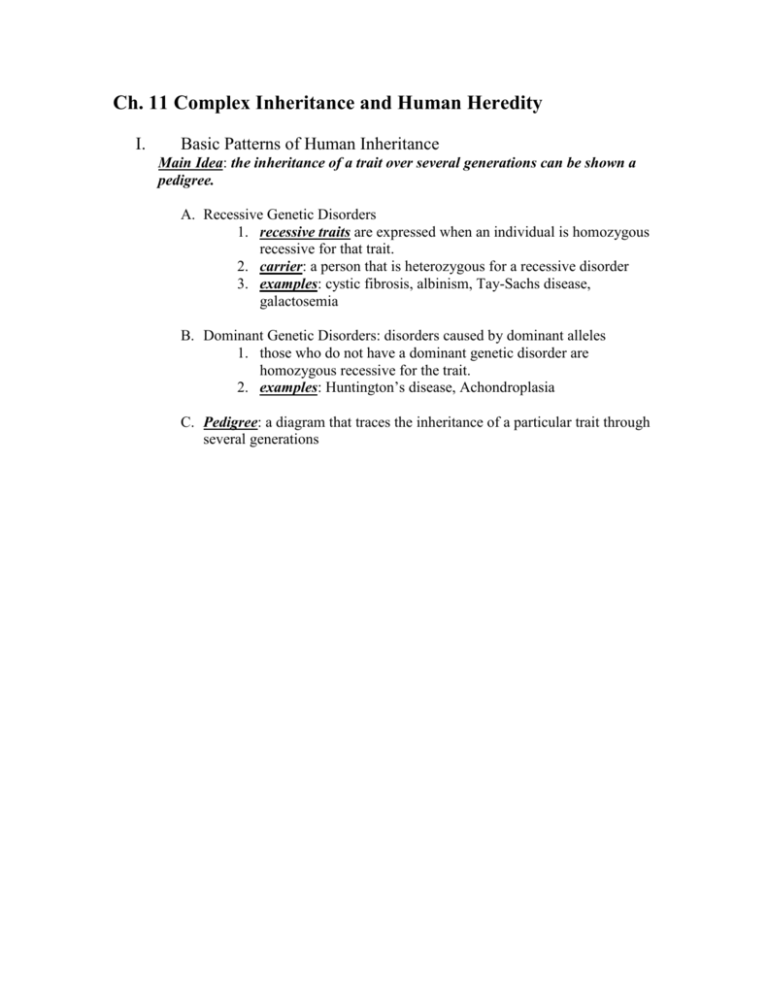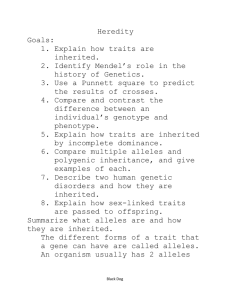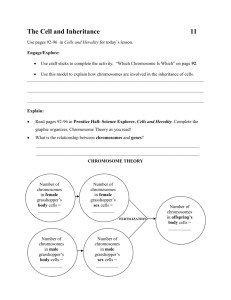Ch.-11-Notes
advertisement

Ch. 11 Complex Inheritance and Human Heredity I. Basic Patterns of Human Inheritance Main Idea: the inheritance of a trait over several generations can be shown a pedigree. A. Recessive Genetic Disorders 1. recessive traits are expressed when an individual is homozygous recessive for that trait. 2. carrier: a person that is heterozygous for a recessive disorder 3. examples: cystic fibrosis, albinism, Tay-Sachs disease, galactosemia B. Dominant Genetic Disorders: disorders caused by dominant alleles 1. those who do not have a dominant genetic disorder are homozygous recessive for the trait. 2. examples: Huntington’s disease, Achondroplasia C. Pedigree: a diagram that traces the inheritance of a particular trait through several generations II. Complex Patterns of Inheritance Main Idea: Complex inheritance of traits does not follow inheritance patterns described by Mendel. A. incomplete dominance: the creation of an intermediate phenotype between two homozygous phenotypes Red Snapdragon x White Snapdragon RR rr Pink Snapdragon Rr B. codominance: both alleles are expressed in the heterozygous condition 1. sickle-cell disease: heterozygous carriers for this disease have both normal and sickle-shaped blood cells. C. multiple alleles: some traits are controlled by more than two alleles for a trait 1. human blood groups: IA = blood type A; IB= blood type B; Type O is the lack of A or B markers; A and B markers are codominant which makes blood type AB. a. Rh factors: blood protein inherited from each parent; Rh+ is dominant over Rh-. 2. rabbit coat color: 4 allele codes: C, cch, ch, c that have descending dominance. a. the presence of multiple alleles increases the number of genotypes and phenotypes: 4 alleles produce 10 possible genotypes and 4 phenotypes. D. Epistasis: the interaction of one allele hiding the effects of another 1. example: Labrador retriever’s coat color: allele for the presence of pigment masks the allele for pigment darkness if there is not pigment present E. Sex Determination 1.sex chromosomes: in humans, 1 pair of chromosomes out of 23 determines gender. a.XX = female, XY = male b. Autosomes: the other 22 pair of human chromosomes that are not sex chromosomes c. Gender of offspring is determined by the combination of sex chromosomes in the egg and sperm cell F. Dosage Compensation 1. X chromosomes are larger than Y and carry genes necessary for both female and male development 2. Y chromosomes mainly have genes that relate to development of male characteristics 3. dosage compensation (X-inactivation): one X chromosome stops working in a female’s body cells to balance getting two doses of X-related genes. a. calico cat fur color results from the random inactivation of a particular X chromosome b. Barr bodies: inactivated X chromosomes in female cell nuclei G. Sex-Linked Traits (X-linked traits): traits controlled by genes located on the X chromosome 1. males are more affected by recessive sex-linked traits since males have only one X chromosome 2. some traits appear to be sex-linked but are not (ex: allele for baldness is recessive in females but dominant in males. 3. examples: red-green color blindness (8% males in U.S.), hemophilia (delayed clotting of blood)—more common in males H. Polygenic traits: traits that arise from the interaction of multiple pairs of genes (ex: skin color, eye color, fingerprint patterns) 1. graphing polygenic traits shows a bell curve I. Environmental Influences: affect phenotype and seriousness of diseases 1. sunlight and water: extremes affect phenotypes (plants may lose leaves, droop, stop growing, chlorophyll disappears) 2. temperature: influences the expression of genes (ex: Siamese cat produces dark pigment on cooler areas of its body) J. Twin Studies: studying identical twins help scientists separate genetic factors from environmental influences 1. factors expressed differently in twins are assumed to be influenced by the environment while those expressed similarly are genetic III. Chromosomes and Human Heredity Main Idea: Chromosomes can be studied using karyotypes. A. Karyotype Studies 1. karyotype: a micrograph of all 23 pairs of human chromosomes stained during metaphase of mitosis 2. telomeres: protective caps of DNA associated with proteins located at the chromosome ends; associated with aging and cancer B. Nondisjunction: cell division during which sister chromatids fails to separate properly; occurs in any organism where gametes are produced through meiosis 1. nondisjunction in meiosis I or II results in gametes that have the incorrect number of chromosomes 2. when one of these gametes fertilizes another gamete, the offspring will not have the correct number of chromosomes 3. trisomy: having a set of three chromosomes of one kind 4. monosomy: having only one of a particular type of chromosome 5. example: Down’s Syndrome is caused by an extra chromosome 21 6. nondisjunction occurs in both autosomes and sex chromosomes (ex: XO = female with Turner’s syndrome, XXY = male with Klinefelter’s syndrome) 7. fetal testing can reveal certain genetic disorders for couples who suspect they might be carriers or older couples a. ex: amniocentesis, Chorionic villus sampling, fetal blood sampling









